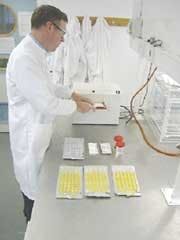By Ed Oliver
When it comes to enhancing water quality, Seattle Public Utilities leverages every technology available, including microbiological testing advances. Since the US-EPA approved Idexx's Defined Substrate Technology (DST®) for coliform testing, Seattle has been using DST coliform test kits in a series of water quality studies. The results have played a key role in reducing coliform occurrence in finished water from 1.5 percent in the early 90's to under 0.2 percent today.
Taking advantage of the accuracy in DST technology, Seattle was able to identify and minimize the biofilm source of its coliforms. Additionally, the testing procedure helped the operations department overcome seasonal variations and improve water quality at its source water intake.
Defined Substrate Technology is a patented method of detecting bacteria through the effect of their constitutive enzymes on chromogenically and fluorogenically labeled, specific substrates. The most frequently used DST method, Colilert®, detects coliforms and E. coli through the activity of the enzymes beta-D-galactosidase and beta-D-glucuronidase respectively. These enzymes are generally accepted as being primary characteristics of coliforms and E. coli. DST tests contain a specific substrate for each of these enzymes. Seattle's results showed the tests eliminate false positives and false negatives, improving operational compliance and efficiency.
To run a DST test, add reagent to a water sample and incubate for 18-24 hours (depending upon the test). In Colilert, coliforms turn the sample/reagent mixture yellow and E. coli make it fluoresce. DST tests can be used for presence/absence results or, when used with Quanti-Tray®, for quantified results. The method is accurate to 1 organism/100ml, requires no media preparation, filtering or confirmation and takes less than 1 minute hands-on time.
Reducing Coliforms
Although Seattle has never had a USEPA coliform violation, members of the water quality team were still interested to see how they could reduce coliforms in a cost-effective manner. Since 1993, Seattle has run three major diagnostic studies that looked at how and why coliforms were regularly found in distribution samples. Insights from the studies have led to wide ranging improvements that have nearly eliminated coliforms from the distribution system.
1. Reducing Biofilms – Internal monitoring during the early 1990s pointed to biofilms as a primary source of coliforms. In 1993, the Water Quality Lab used the DST method to determine the effectiveness of uni-directional lines flushing on the reduction of coliform levels. The laboratory tested 110 samples of sediments flushed from distribution lines. (Oliver, Ed and R. Pimental. (Reduction of Coliforms in Sediments Indicates Flushing Program Success. Technol. Conf. Proceedings AWWA, Boston, MA (1996)). 38.2 percent of the tests read positive at the beginning of the study and after two years of regular flushing, this number had been reduced to only 6.4 percent positives.
The results of the program showed two things. First, regular flushing can be an effective way of removing coliforms in biofilms. Seattle now relies on periodic flushing programs to maintain top quality water.
Secondly, membrane filtration methods missed 15 of 42 coliform-positive samples. These atypical coliforms didn't confirm in lactose-based broth after 48 hours of incubation. The DST method provided Seattle with a more effective tool for coliform testing than lactose-based methods. The method's low false negative rate allows Seattle to identify and correct biofilm issues long before they become a regulatory concern.
2. Reducing False Positives - Following the success of the flushing program, Seattle Public Utilities tested Defined Substrate Technology to determine its ability to avoid false positives due to Aeromonas hydrophila. These non-coliforms can be found in distribution systems and can produce false positives in other coliform tests, including membrane filtration.
No false positives were found when DST tests were used on any of the 54 cultures isolated from the Seattle distribution system, even when spiked with concentrations as high as 500,000 per 100ml sample. This is well over the USEPA Surface Water Treatment Rule MCL of 500 cfu/ml of heterotrophs. Seattle concluded that new testing method reduced the possibility of false-positives due to this gram-negative bacterium.
These two studies brought about changes that have dramatically reduced coliform positives. Consequently, Seattle has switched from membrane filtration to Defined Substrate Technology methods for all of its finished water testing.
3. Improving Source Water Quality - After converting to DST for finished water, the Water Quality Lab evaluated its suitability for source water testing. Using samples from the Youngs Lake Reservoir, the lab compared Colilert®-18 reagent used with Quanti-Tray®/2000 to the multiple tube fermentation method. Each method can be used to enumerate coliforms and E. coli. The Quanti-Tray/2000 MPN method proved more accurate, and the data led to improved operations at Seattle's new treatment facility.
For example, the study showed that coliforms tend to stratify at changing depths in Seattle's reservoir. Seasonal changes in temperature shifted these strata, affecting the quality of the water drawn at the intake. Using accurate enumeration data, Seattle engineers now select the depth at which they draw the city's source water, optimizing for the highest water quality.
Conclusion
Defined Substrate Technology tests have helped the Water Quality Lab assess Seattle's entire water system. As a result, operational improvements have improved water quality for ratepayers. The testing method's lower false negative rate provides Seattle with a tool for ongoing process improvement, while its reduced false positives improve operational efficiency and compliance. As an added bonus, the water lab found the tests easy to use. Compared to the membrane filtration method, they require less hands-on time and their ability to provide a completed result eliminated many hours of media preparation, disinfection and confirmation.
About the Author: Ed Oliver is a Water Quality Analyst at the Seattle Public Utilities. He has worked as a microbiologist in the water industry for 25 year and has written eight papers on characterizing distribution system coliform bacteria. The topics on these papers have ranged from reducing coliform-positive distribution samples by flushing and increased chlorine residuals to comparing new methods for detecting coliforms in sediments and biofilms.





